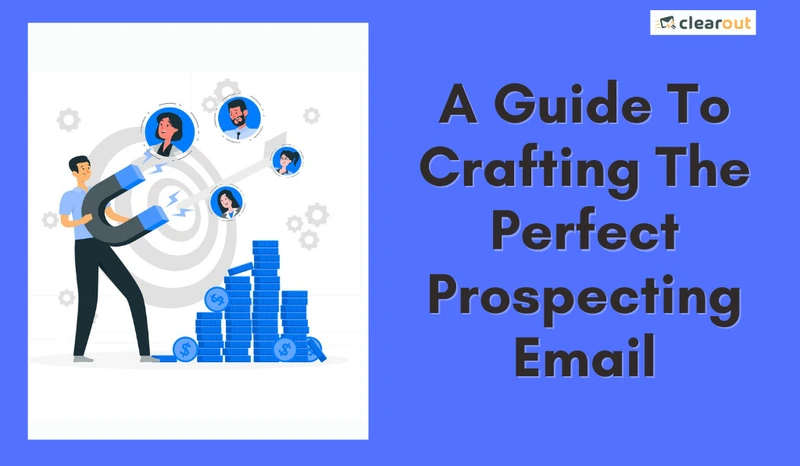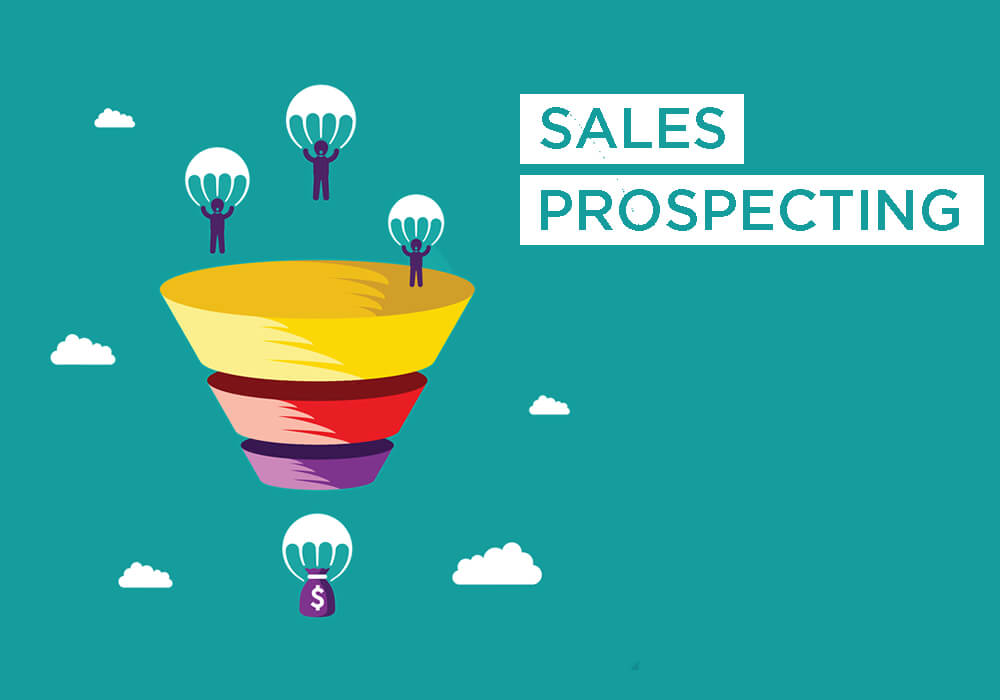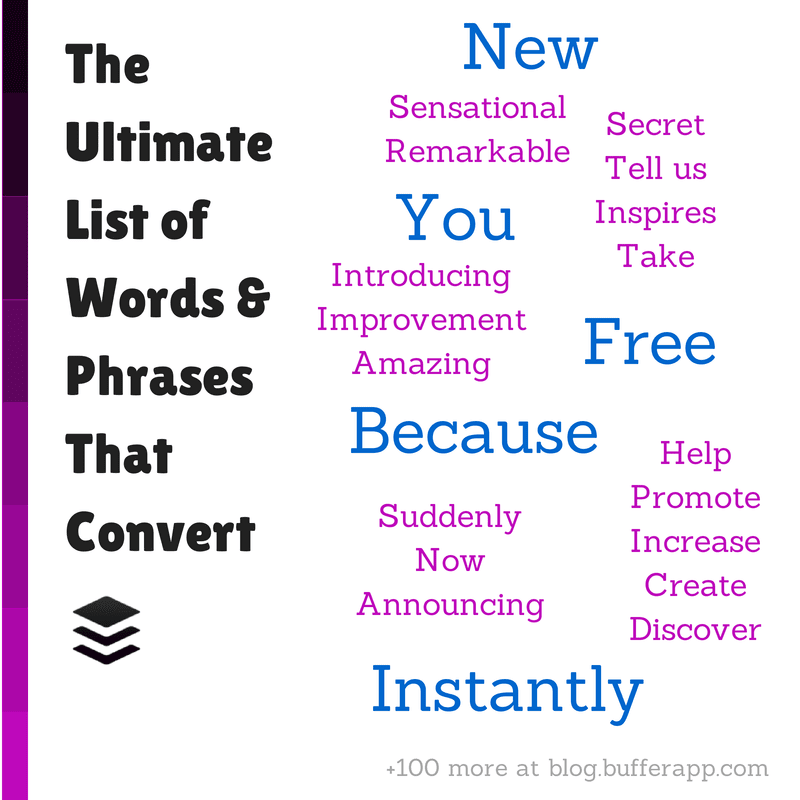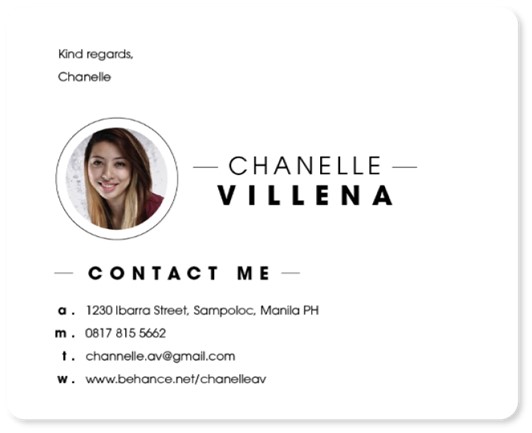- Products
- ProspectSQL/MQL list building with high levels of personalization, real-time data enrichment and prospect search
- Email FinderFind individual or bulk emails by entering the person & company name or domain
- Email VerifierVerify emails addresses individually, in bulk or through API, with 99% accuracy
- Clearout For SheetsVerify email addresses directly on Google Sheets with Clearout for sheets add-on
- ClearoutPhoneValidate phone numbers across 240+ countries in bulk, quick or real time validation Free Tools
- Disposable Email Checker
- Reverse LinkedIn Profile Lookup Tool
- Reverse Email Lookup Tool
- Email List Cleaner
- Resource
- Pricing
- Integrations
- Enterprise
- Login
A Guide To Crafting The Perfect Prospecting Email

Think prospecting emails are a waste of time? Think again.
While many sales reps believe they are ineffective, they're one of the most powerful tools in any sales rep's arsenal.
Benefits of email marketing are abundant, and this method is still very much alive and kicking. In fact, four out of five marketers state that they'd rather give up social media than email marketing.
However, if you are one of those sales reps who believe "cold emailing" is too difficult to get right, we have exactly what you need. We've put together a complete guide that would help you master the art of crafting the perfect prospecting email.
Let’s quickly cover the basics first.
While many sales reps believe they are ineffective, they're one of the most powerful tools in any sales rep's arsenal.
Benefits of email marketing are abundant, and this method is still very much alive and kicking. In fact, four out of five marketers state that they'd rather give up social media than email marketing.
However, if you are one of those sales reps who believe "cold emailing" is too difficult to get right, we have exactly what you need. We've put together a complete guide that would help you master the art of crafting the perfect prospecting email.
Let’s quickly cover the basics first.
What is a Prospecting Email?
A prospecting email is a type of email that you send to people who don't know you, in order to introduce yourself and build a relationship. Prospecting emails are often sent to potential customers, but can also be sent to potential partners or investors.
The purpose of prospecting emails is to generate interest in your product or service by contacting those potential customers or leads. By doing this, you're essentially "prospecting" for new business.
The purpose of prospecting emails is to generate interest in your product or service by contacting those potential customers or leads. By doing this, you're essentially "prospecting" for new business.
Benefits of Prospecting Emails
While cold emailing might feel like the most difficult part of your job, it's also one of the best ways to reach your biggest customers. Here are the top benefits of sending cold emails:
- They're easy to do - You don't have to rely on luck or good timing, as you can send prospecting emails at your convenience. It's a great way to target customers or leads when they're most likely to open and engage with the email.
- They're inexpensive - Unlike paid ads, sending a prospecting email only costs you time, not money. This means they will yield a higher ROI while not costing you almost nothing. You have nothing to lose either.
- They can be personalized- You can use personalized emails to connect better with your reader. Personalization makes them feel special and more likely to read and respond to your emails.
- They're useful for everyone - Whether you're a startup or a billion-dollar company, emails give you the opportunity to connect with new customers and improve your established relationships with existing customers.
- You can use them to build a long-term relationship - When you send a cold email, you're initiating a connection with your prospect. Once they trust you, you can use the collected information from your initial outreach to start better conversations and create future opportunities.
How To Write The Perfect Prospecting Emails?

Source: PhoneBurner
So now you know what a prospecting email is and why it's helpful. But what makes a good prospecting email?
We've broken down the essentials to writing an effective prospecting email so you can find success in no time.
We've broken down the essentials to writing an effective prospecting email so you can find success in no time.
1. Verify your prospect list
Your prospecting emails will yield results only when they land in an inbox.
But what if you spend your time and efforts crafting emails, and send it to an invalid email address? Feels bad, right?
Thus, the first thing you should do is to verify your prospects and validate their email addresses before sending out your prospecting emails. This will make sure your emails reach where they belong and reduce bounce rates.
But what if you spend your time and efforts crafting emails, and send it to an invalid email address? Feels bad, right?
Thus, the first thing you should do is to verify your prospects and validate their email addresses before sending out your prospecting emails. This will make sure your emails reach where they belong and reduce bounce rates.
2. Make your subject line irresistible
Subject lines can make a huge difference. While a poorly written subject line results in low open rates, an engaging email subject line can shoot up your open rate up to 80%. A great prospecting email should grab the reader's attention right away and make them want to open your email.
When writing your subject lines, remember the three C’s of copywriting:
When writing your subject lines, remember the three C’s of copywriting:
- Clear: Your subject line shouldn't contain any jargon, and should reflect what the email is about. If your prospect has to guess what your email is about, they're less likely to open it.
- Concise: Cut to the chase. To keep your prospect’s attention, your subject line should be no longer than nine words, or 60 characters. Your readers don't need to hear about all the technical features of your customer journey mapping tools. They just want to know one thing - how they can solve their problems.
- Compelling: Your subject line should make the prospect curious enough to open the email and learn more. Maybe you do this by using numbers (e.g., "3 Reasons You'll Love Our Product"), using pain points as your subject line ("Here’s why your ROI of content marketing is tanking"), or being funny/quirky ("Hey, You! Yes, You. Read This Email").
3. Use power words
Using power words in copywriting is a great way to generate more responses from your prospecting email without having to write anything groundbreaking. Our brains are pretty emotional, so words that elicit strong feelings will get people to read on. Different power words can be used in a variety of different ways, from boosting the tone of your email to adding more personality.
Believe it or not, the best power word of all is the word "you." That's because it puts your reader in the driver's seat. When you write "you will" or "you could," you're giving people the opportunity to imagine themselves benefiting from your product or service.
Let's say you're a marketing company that helps companies secure backlinks. Rather than saying, "This is the most effective way to increase site visibility on Google", say, "We'll help you get more traffic to your site." Other power words include: imagine, discover, learn, easy, proven, and result.
Believe it or not, the best power word of all is the word "you." That's because it puts your reader in the driver's seat. When you write "you will" or "you could," you're giving people the opportunity to imagine themselves benefiting from your product or service.
Let's say you're a marketing company that helps companies secure backlinks. Rather than saying, "This is the most effective way to increase site visibility on Google", say, "We'll help you get more traffic to your site." Other power words include: imagine, discover, learn, easy, proven, and result.
4. Include social proof
Social proof is a tremendously powerful way of making your prospecting email look more legitimate. It’s essentially a psychological phenomenon where people copy the behavior of others in an attempt to reflect correct behavior.
In fact, Studies show that 87% of consumers trust online reviews. So including a form of social proof in your emails can improve your response rates significantly.
For example, if you’re promoting your training course on product personalisation, you could include a testimonial from a product manager who has taken the course and enjoyed it.
You can also include statistics, and use case studies in your emails to make an impact on your readers.
In fact, Studies show that 87% of consumers trust online reviews. So including a form of social proof in your emails can improve your response rates significantly.
For example, if you’re promoting your training course on product personalisation, you could include a testimonial from a product manager who has taken the course and enjoyed it.
You can also include statistics, and use case studies in your emails to make an impact on your readers.
5. Send your prospecting email at the right time
Picture this. You've just crafted an engaging prospecting email filled with a brilliant subject line, power words and social proofs. You hit the send button hoping for a great response, but nothing happens.
Reason? Timing.
Timing is everything with prospecting emails. If you send your email at the right time, you'll definitely increase click rate. However, sending it at the wrong time, means adding your emails to the heaps of email that just sits in the inbox, and eventually gets deleted.and you could risk it being missed. Therefore you need to find the ideal time when your leads are more likely to notice and open your email.
In a compiled research, Coschedule concluded that most businesses found greater success when sending emails at 6 am, 10 am, 2 pm, and 8 pm. However, it will take some trial and error to help you find which timing works best for your target audience. You can refer to the above time slots while getting started.
Reason? Timing.
Timing is everything with prospecting emails. If you send your email at the right time, you'll definitely increase click rate. However, sending it at the wrong time, means adding your emails to the heaps of email that just sits in the inbox, and eventually gets deleted.and you could risk it being missed. Therefore you need to find the ideal time when your leads are more likely to notice and open your email.
In a compiled research, Coschedule concluded that most businesses found greater success when sending emails at 6 am, 10 am, 2 pm, and 8 pm. However, it will take some trial and error to help you find which timing works best for your target audience. You can refer to the above time slots while getting started.
6. Add a professional email signature
An email signature is your identity, placed at the footer of your email. It includes information such as your full name, contact information, and the company you work for.
When reaching out to cold contacts, it's essential to ensure that you're coming across as professional as possible. This will help your reader trust you, your business, your products and services.
A great way to ensure that you're appearing professional is by ensuring that your email signature looks good! Simply writing your name at the end of your email won't achieve the level of trust you're hoping you gain from your potential leads.
Instead, be sure to add your company logo, a link to your website and social channels, and a contact number they can reach you on. Here’s a perfect example:
When reaching out to cold contacts, it's essential to ensure that you're coming across as professional as possible. This will help your reader trust you, your business, your products and services.
A great way to ensure that you're appearing professional is by ensuring that your email signature looks good! Simply writing your name at the end of your email won't achieve the level of trust you're hoping you gain from your potential leads.
Instead, be sure to add your company logo, a link to your website and social channels, and a contact number they can reach you on. Here’s a perfect example:
7. Bonus:- Follow up after your prospecting email
Your prospecting emails aren't going to be a hit every time, but that's okay. You can always learn from your mistakes and apply what you've learned to future emails.
The key is in following up with prospects after a few weeks of sending out your prospecting emails. If, for some reason, your email didn't hit the inbox, or it wasn't opened, then there's a lot of room for improvement.
However, if they did open your email and didn't respond after a few weeks, chances are they read everything you said or maybe just missed it because of their busy schedule. In any case, you'll want to follow up with them to make sure they get what you said. Follow up emails have proven to be extremely effective. In fact, according to Copper Chronicles, sending follow-up emails can triple your reply rate.
The key is in following up with prospects after a few weeks of sending out your prospecting emails. If, for some reason, your email didn't hit the inbox, or it wasn't opened, then there's a lot of room for improvement.
However, if they did open your email and didn't respond after a few weeks, chances are they read everything you said or maybe just missed it because of their busy schedule. In any case, you'll want to follow up with them to make sure they get what you said. Follow up emails have proven to be extremely effective. In fact, according to Copper Chronicles, sending follow-up emails can triple your reply rate.
Final thoughts
So there you have it - our complete guide to crafting the perfect prospecting email.
Sending prospecting messages can be a great way to get in touch with potential clients, but only if you're sending them at the right time.
Practicing the above tips for perfect prospecting emails will give you an edge when reaching out to new clients or customers.
Remember, marketing mavens aren't made overnight. It's your job to learn from your mistakes and improve on future emails. But with these new tips, you'll be sending the perfect prospecting email in no time. Good luck and happy emailing!
Author Bio:
Nick Brown - Accelerate Agency
Nick Brown is the founder & CEO of accelerate, a SaaS company who exclusively partners with enterprise tech companies to scale their SEO and content marketing. Nick has launched several successful online businesses, written and published a book and grown accelerate from a UK based agency that now operates across US, APAC and EMEA. He has written for sites like ConcreteCMS and RingCentral UK.
Sending prospecting messages can be a great way to get in touch with potential clients, but only if you're sending them at the right time.
Practicing the above tips for perfect prospecting emails will give you an edge when reaching out to new clients or customers.
Remember, marketing mavens aren't made overnight. It's your job to learn from your mistakes and improve on future emails. But with these new tips, you'll be sending the perfect prospecting email in no time. Good luck and happy emailing!
Author Bio:
Nick Brown - Accelerate Agency
Nick Brown is the founder & CEO of accelerate, a SaaS company who exclusively partners with enterprise tech companies to scale their SEO and content marketing. Nick has launched several successful online businesses, written and published a book and grown accelerate from a UK based agency that now operates across US, APAC and EMEA. He has written for sites like ConcreteCMS and RingCentral UK.
Recent Posts
01 Jul 2025
Best Zoho CRM Integrations for Sales & Marketing in 2025
Discover the top Zoho CRM integrations in 2025 categorized by use case. Explore how each tool's key ...
01 Jul 2025
Sales Automation in 2025: The Guide to Close More Deals Faster
Struggling with manual sales workflows? Follow this guide to explore the sales automation use cases, ...
25 Jun 2025
Top 6 Email Finder APIs in 2025 for All Use Cases
Looking for a reliable Email Finder API? Explore the top 6 email finder APIs of 2025—compare key fea ...
17 Jun 2025
Top 10 Email Spam Checker Tools Tested & Reviewed (2025)
Check out the top 10 email spam checker tools to avoid junk folders. Compare features, ratings & use ...
06 Jun 2025
How To Create a Lead Magnet That Converts in 2025
Looking for more leads? Read how to create a high-converting lead magnet in 2025 with step-by-step g ...
Prospecting ,Email Finder & Email Verification Service
Prospecting ,Email Finder & Email Verification Service
Expand your reach by discovering and verifying the ideal prospects.
Sign up & get 100 free credits | No Credit Card required




